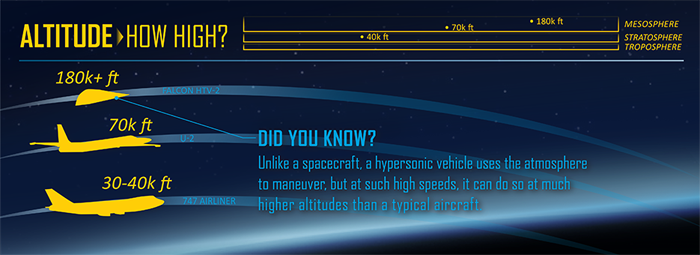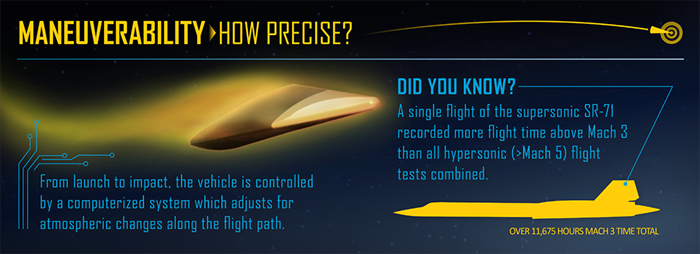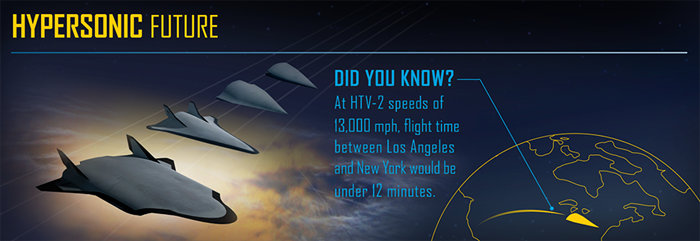.
The ability to travel at incredibly fast speeds is a hallmark of science fiction movies—the Enterprise, Starship Galaxy and Millennium Falcon—all have their roots in aircraft or space planes that can travel at speeds well over Mach 5.
But today, the dream of traveling across the world (or galaxy) in a few short hours is getting a little closer to reality. Researchers at Lockheed Martin are taking lessons from early hypersonic flights, as well as the latest advancements in aviation technology, to design and develop the next wave of hypersonic vehicles.
Past Innovation, Future Application
More than 50 years ago, a Boeing B-52 Stratofortress aircraft took off from Edwards Air Force Base in the hot, dry desert of California, carrying under its wing a rocket-powered experimental aircraft—the North American X-15.
At 45,000 feet, the X-15 was launched into flight, reaching speeds of 522 miles per hour and landing at Rogers Dry Lake just a few miles away.
While the pilot would only have five minutes of actual flying time, the monumental first flight of the X-15 would set the stage for later tests of the winged aircraft that would be the first to attain velocities of Mach 4, 5 and 6.
The era of hypersonic flight had arrived.
Hoping to reduce costs and build aircraft more efficiently—designers are taking cues from these early aircraft, as well as modern-day marvels like the F-35. No matter the vehicle’s purpose, three key factors must be included in the design:
SPEED
.

Modern passenger airplanes fly at 550 miles per hour or about 8 miles per minute. A Mach 2 fighter jet flies about 1,400 miles per hour or about 20 miles per minute. Depending on the type of mission, Lockheed Martin engineers are designing hypersonic vehicles to fly anywhere between 1 mile per second (for a scramjet powered missile) and 4 miles per second like the Hypersonic Technology Vehicle-2 (HTV-2) flew in 2011.
Designing for such speeds is the most obvious factor when it comes to developing a hypersonic vehicle, but how do engineers do it?
“It’s all about the heat,” said hypersonics expert Brad Leland. At speeds of Mach 5 and higher, aerodynamic friction can heat an aircraft's exterior enough to melt steel. Advanced materials, recently in development, are necessary.
“Through simulation and testing, we are able to analyze properties of microstructures, using this knowledge to develop new materials with new properties,” said research scientist Jason Poleski. “This isn’t just about using the latest in heat-resistant materials. In order to manage heat dissipation, we need to consider both materials on a microscale as well as the vehicle topology in order to create a vehicle that won’t melt under the heat caused by wind resistance at Mach speeds.”
ALTITUDE
.

People will never see a hypersonic vehicle of any sort flying below 60,000 feet because the atmospheric pressure is so great that it would burn up or explode from the forces. High altitudes lower the pressure forces on a hypersonic vehicle to levels that allow it to stay together. A hypersonic vehicle at ground level would experience pressures greater than 700 pounds per square inch—that’s like an elephant standing on your foot!
According to Leland, like designing for speed, a hypersonic vehicle must be designed for extreme temperatures.
“Nothing can be hanging out in the breeze or else it burns off,” he said.
At the same time, the air is extremely thin, so it can be hard to steer the vehicle. And any small discontinuity or bump on the vehicle produces enough unexpected forces to disrupt the steering.
MANEUVERABILITY
.

When you’re traveling at Mach speeds, you need to make sure you’ve got complete control over the system that’s flying. This is arguably the most critical to pilot safety.
“Things happen so fast at those speeds that a person cannot react quickly enough,” Leland said. To counter that issue, pilots use computers to control the vehicle. Doing so allows the pilot to direct the vehicle to perform maneuvers while the computer balances the vehicle the entire time.
IN THE FUTURE
.

In the future, hypersonic travel could allow us to fly across the Pacific Ocean in only one to two hours and even launch cargo and people into space quickly and affordably.
Needless to say, there’s much room for innovation left in the world of aerospace.
“Every engineer has the opportunity to contribute to a new and mostly undiscovered field of aerodynamics like hypersonics,” said Leland. “Today we are focusing on making hypersonic systems practical, fieldable and most of all affordable.”
Quelle: Lockheed Martin
5001 Views
